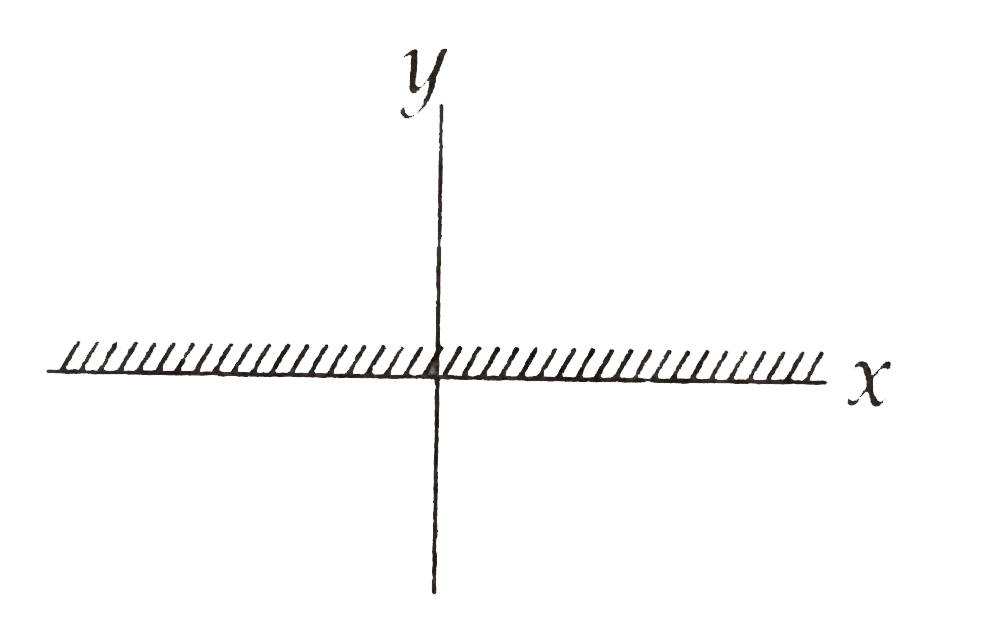A plane mirror is placed at origin parallel of y-axis, facing the positive x-axis. An object starts from (2m, 0, 0) with a velocity of (2ˆi+2ˆj)m/s. The relative velocity of image with respect to object is along
positive x-axis
negative x-axis
positive y-axis
negative y-axis
The correct Answer is:B
To solve the problem, we need to analyze the motion of the object and its image in relation to the mirror. Here’s a step-by-step solution:
Step 1: Understand the setup
- The plane mirror is placed at the origin (0, 0) and is parallel to the y-axis, facing the positive x-axis.
- The object starts at the point (2m, 0, 0) and has an initial velocity of →Vo=2^i+2^j m/s.
Step 2: Determine the position of the image
- The image of the object in a plane mirror is located at an equal distance behind the mirror. Since the object is at (2m, 0, 0), the image will be at (-2m, 0, 0).
Step 3: Determine the velocity of the image
- The velocity of the image (→Vi) is equal in magnitude but opposite in direction to the velocity of the object. Therefore, the velocity of the image is:
→Vi=−→Vo=−(2^i+2^j)=−2^i−2^j m/s
Step 4: Calculate the relative velocity of the image with respect to the object
- The relative velocity of the image with respect to the object (→Vrel) is given by:
→Vrel=→Vi−→Vo
Substituting the values:
→Vrel=(−2^i−2^j)−(2^i+2^j)=−2^i−2^j−2^i−2^j
→Vrel=−4^i−4^j m/s
Step 5: Determine the direction of the relative velocity
- The relative velocity vector →Vrel=−4^i−4^j indicates that the relative velocity has components in both the negative x-direction and the negative y-direction. However, since the question asks for the direction of the relative velocity of the image with respect to the object, we focus on the x-component, which is negative.
Conclusion
- The relative velocity of the image with respect to the object is directed along the negative x-axis.
- The plane mirror is placed at the origin (0, 0) and is parallel to the y-axis, facing the positive x-axis.
- The object starts at the point (2m, 0, 0) and has an initial velocity of →Vo=2^i+2^j m/s.
- The image of the object in a plane mirror is located at an equal distance behind the mirror. Since the object is at (2m, 0, 0), the image will be at (-2m, 0, 0).
- The velocity of the image (→Vi) is equal in magnitude but opposite in direction to the velocity of the object. Therefore, the velocity of the image is:
→Vi=−→Vo=−(2^i+2^j)=−2^i−2^j m/s
- The relative velocity of the image with respect to the object (→Vrel) is given by:
→Vrel=→Vi−→Vo
Substituting the values:
→Vrel=(−2^i−2^j)−(2^i+2^j)=−2^i−2^j−2^i−2^j
→Vrel=−4^i−4^j m/s
- The relative velocity vector →Vrel=−4^i−4^j indicates that the relative velocity has components in both the negative x-direction and the negative y-direction. However, since the question asks for the direction of the relative velocity of the image with respect to the object, we focus on the x-component, which is negative.
- The relative velocity of the image with respect to the object is directed along the negative x-axis.
Topper's Solved these Questions
- RAY OPTICSBook:DC PANDEY ENGLISHChapter:RAY OPTICSExercise:B. More than one option is correct
Explore 20 Videos
- RAY OPTICSBook:DC PANDEY ENGLISHChapter:RAY OPTICSExercise:C. comprehension type question
Explore 14 Videos
- RAY OPTICSBook:DC PANDEY ENGLISHChapter:RAY OPTICSExercise:Integer type q.
Explore 14 Videos
- PROPERTIES OF MATTERBook:DC PANDEY ENGLISHChapter:PROPERTIES OF MATTERExercise:Integer
Explore 8 Videos
- ROTATIONBook:DC PANDEY ENGLISHChapter:ROTATIONExercise:(C) Chapter Exercises
Explore 39 Videos
Similar Questions
A plane mirror is placed along positive x-axis facing towards positive y-axis. If the equation of a linear object is x=y, the equation of its image is
View SolutionA plane mirror placed at the origin has ˆi as the normal vector to its reflecting surface. The mirror beings to translate with a velocity ˆi+ˆj+ˆk. At the same time an object which was initially at ˆi+ˆj starts moving with a velocity (ˆi+ˆj)m/s Now choose the correct options.
View Solution
Knowledge Check
A plane mirror is placed along the x-axis facing negative y-axis. The mirror is fixed, A point object is moving with 3ˆi+4ˆj in front of the plane mirror. The relative velocity of image with respect to its object is
 A−8ˆjB8ˆjC3ˆi−4ˆjD−6ˆi
A−8ˆjB8ˆjC3ˆi−4ˆjD−6ˆi
A plane mirror is on y-z plane facing positive x-axis. A point object is present at (10,5). The mirror is translated by 2 units along positive x and 3 units along positive y-direction. Final image of the point object is at
View SolutionConsider a point object moving towards a stationary plane mirror with velocity 5m/s. Find velocity of image w.r.t object
View SolutionAn object A is moving with 5 m/s and B is moving with 20 m/s in the direction . (positive x-axis )
find velocity of A with respect to B .
View SolutionAn object is moving towards a stationary plane mirror with a speed of 2 m/s. Velocity of the image w.r.t. the object is
View SolutionA point object is placed on the principle axis at 60cm in fornt of a concave mirror of focal length 40cm on the principle axis. If the object is moved with a velocity of 10cm/s (a) find velocity of image along principle axis (b) perpendicular axis, find the velocity of image at the moment.
View SolutionA plane mirror is moving with velocity −2ˆi−3ˆj+4ˆk. A point object in front of the mirror move with a velocity −3ˆi+4ˆj−4ˆk.
There ˆj is along the normal to the plane mirror and facing towards the object. Find velocity of image.
View SolutionAn object A is moving with 5 m/s and B is moving with 20 m/s in the same direction. (Positive x-axis). Find a) velocity of B relative to A.
b) Velocity of A relative to B
View Solution